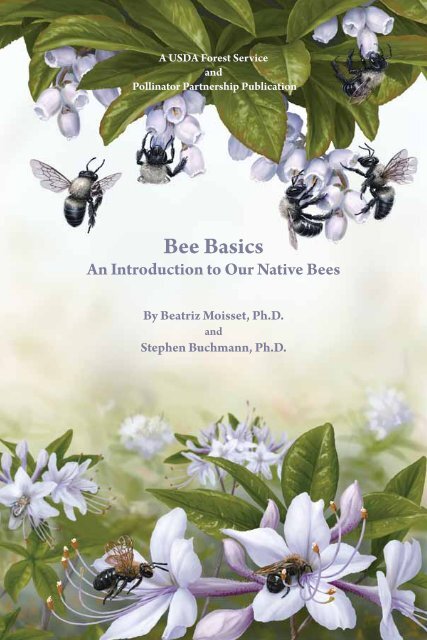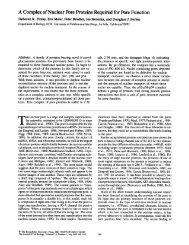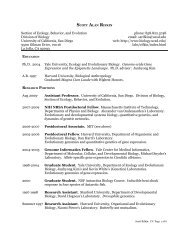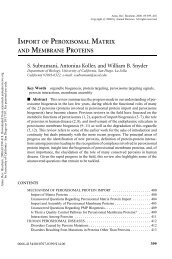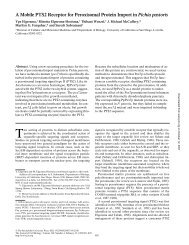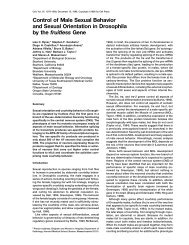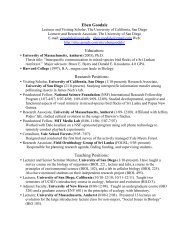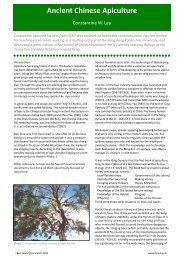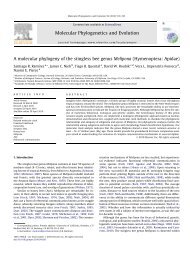Bee Basics - USDA Forest Service - US Department of Agriculture
Bee Basics - USDA Forest Service - US Department of Agriculture
Bee Basics - USDA Forest Service - US Department of Agriculture
Create successful ePaper yourself
Turn your PDF publications into a flip-book with our unique Google optimized e-Paper software.
A <strong><strong>US</strong>DA</strong> <strong>Forest</strong> <strong>Service</strong>andPollinator Partnership Publication<strong>Bee</strong> <strong>Basics</strong>An Introduction to Our Native <strong>Bee</strong>sBy Beatriz Moisset, Ph.D.andStephen Buchmann, Ph.D.
A <strong><strong>US</strong>DA</strong> <strong>Forest</strong> <strong>Service</strong> and Pollinator Partnership Publication<strong>Bee</strong> <strong>Basics</strong>:An Introduction toOur Native <strong>Bee</strong>sBy Beatriz Moisset, Ph.D.andStephen Buchmann, Ph.D.Illustrations by Steve Buchanan
A <strong><strong>US</strong>DA</strong> <strong>Forest</strong> <strong>Service</strong> and Pollinator Partnership PublicationUnited States <strong>Department</strong> <strong>of</strong> <strong>Agriculture</strong>AcknowledgmentsEdited by Larry Stritch, Ph.D.Julie NelsonTeresa PrendusiLaurie Davies Adams
Worker honey bees (Apismellifera) visiting almondblossoms (Prunus dulcis).IntroductionNative bees are a hidden treasure. From alpine meadows in the nationalforests <strong>of</strong> the Rocky Mountains to the Sonoran Desert in the CoronadoNational <strong>Forest</strong> in Arizona and from the boreal forests <strong>of</strong> the Tongass National<strong>Forest</strong> in Alaska to the Ocala National <strong>Forest</strong> in Florida, bees can be foundanywhere in North America, where flowers bloom. From forests to farms, fromcities to wildlands, there are 4,000 native bee species in the United States, fromthe tiny Perdita minima to large carpenter bees.Most people do not realize that there were no honey bees in America beforeEuropean settlers brought hives from Europe. These resourceful animalspromptly managed to escape from domestication. As they had done formillennia in Europe and Asia, honey bees formed swarms and set up nests inhollow trees. Native pollinators, especially bees other than honey bees, havebeen pollinating the continent’s flowering plants since long before the arrival <strong>of</strong>honey bees. Even in today’s vastly altered landscapes, they continue to do theyeomen’s share <strong>of</strong> pollination, especially when it comes to native plants.The honey bee, remarkable as it is, does not know how to pollinate tomato oreggplant flowers. It does very poorly compared to native bees when pollinatingmany native plants, such as pumpkins, cherries, blueberries, and cranberries.Let us take a closer look at this forgotten treasure <strong>of</strong> native bees.1
Native <strong>Bee</strong>s: Varied and ValuableNative bees come in a wide array <strong>of</strong> sizes, shapes, and colors. They are alsovaried in their life styles, the places they frequent, the nests they build, theflowers they visit, and their season <strong>of</strong> activity. They remain ignored or unknownby most <strong>of</strong> us. Yet, they provide an invaluable ecosystem service, pollination,to 80 percent <strong>of</strong> flowering plants. What would our world be like without thebeauty <strong>of</strong> flowering trees, shrubs, and wildflowers? How many <strong>of</strong> us knowthat bees pollinate approximately 75 percent <strong>of</strong> the fruits, nuts, and vegetablesgrown in this country?<strong>Bee</strong>s are efficient foragers. One example is the southeastern blueberry bee,Habropoda laboriosa, a hard working little creature capable <strong>of</strong> visiting as manyas 50,000 blueberry flowers in her short life and pollinating enough <strong>of</strong> them toproduce more than 6,000 ripe blueberries. At market those 6,000 blueberriesare worth approximately $20 or more. Not every bee that you see flitting aboutmay be worth $20, but all <strong>of</strong> them combined keep the world <strong>of</strong> floweringplants going. The world as we know it would not exist if there were no bees topollinate the earth’s 250,000 flowering plants.U.S.’s smallest bee (Perditaminima) face to face with afemale large carpenter bee(Xylocopa varipuncta).2
<strong>Bee</strong> Anatomy orMorphologyLike all insects, bee bodies arecomprised <strong>of</strong> a head, thorax, andabdomen. They also have six legs andtwo pairs <strong>of</strong> wings.The head features:• two antennae that are used totouch and “smell”;• two compound eyes and threesimple eyes;• mandibles or jaws used forbiting, working wax and pollen“loaves,” and digging.The thorax features:• two pairs <strong>of</strong> membranous wings,linked in flight by minute hooks;• three pair <strong>of</strong> legs.The abdomen features:• six segments in females, sevensegments in males;• internal wax glands (only inhoney bees and bumble bees);• a stinger (modified ovipositor)at the tip (females only);• branched hairs (plumose)SOMEWHERE on the body.Some females have pollen transportstructures, called scopae, made <strong>of</strong> stiffhairs located on the hind legs or underthe abdomen. <strong>Bee</strong>s frequently brushthemselves, gathering pollen grainsfrom their body’s feathery hairs andtransferring the pollen grains to theirtransport structure.4
5A male digger bee (Anthophoracentriformis) with major bodyparts labeled. Inset shows pollengrains caught in the branched hairsthat distinguish bees from wasps.
Ecologically, bees can be separated into two groups based on the relativelength <strong>of</strong> mouthpart segments within their tongues, called proboscides. Thelong and short tongues are used to gathernectar.Some long-tongued bees likeApidae and Megachilidae,favor deep flowers with aA long-tongued bee(Anthophora centriformis)drinking nectar froma beardstongue flower(Penstemon parryi).A short-tongued bee in the genusColletes taking nectar from theshallow florets <strong>of</strong> a sunflower(Helianthus annuus)6
longer throat; they are not averse to collecting nectar from open flat flowers.The remaining families are made up <strong>of</strong> short-tongued bees and are morelimited in their floral choices. They are only able to take advantage <strong>of</strong> shallowflowers, such as those <strong>of</strong> the daisy or aster family and those <strong>of</strong> the carrot family.Generally, females are larger than male bees, although there may be someoverlap in size.NestingAll bee families have species that take care <strong>of</strong> their young, by building nestsand providing food for them. But several families, Apidae, Halictidae, andMegachilidae, have some species that take advantage <strong>of</strong> their relatives. Theyhave become “cuckoos,” just like there are cuckoos among birds. As withcuckoo birds (like cowbirds), cuckoo bees lay their eggs in the nests <strong>of</strong> others.Most species <strong>of</strong> cuckoo bees only lay their eggs in the nests <strong>of</strong> a few bee species.There are cuckoo bee species that only parasitize the nests <strong>of</strong> a single species.In some species <strong>of</strong> cuckoo bees, the female kills the host’s larva before layingher egg. However, the majority <strong>of</strong> cuckoo bee larvae feed on the stored foodand the larvae <strong>of</strong> the unfortunate hosts. Cuckoo bees do not gather pollen andhave lost their pollen baskets and much <strong>of</strong> their hair. In fact, at first glancesome cuckoo bees are <strong>of</strong>ten mistaken for wasps. Cuckoo bees do visit flowersto feed on the flower’s nectar.Aside from cuckoo bees, all bees build nests, stocking them with a nutritiousmixture <strong>of</strong> pollen, nectar, and saliva before laying their eggs, and sealing themso the larvae remain safe. They generally mix the dry pollen with some nectar,kneading it into a pollen loaf used to feed their young. They add their ownsaliva to this mixture. The saliva is thought to be an important ingredient thatprovides protection against bacterial and fungal infections.Some native bees build their nests underground; others use hollow stems orholes in trees, usually left by beetles; and some use their powerful jaws to makeholes in wood. Whatever their method, they start the job <strong>of</strong> nest building bycarefully choosing the best real estate; if conditions are not right, they continuetheir search. It would not do to have their homes flooded or lacking enoughsunshine, or being too large or too small for their needs. Except for honeybees and bumble bees, females <strong>of</strong> solitary bees provide in one cell all the foodrequired by their larvae to become an adult. This is called mass provisioning.7
Nesting Practices DifferMinersSome members <strong>of</strong> the larger families, Apidae, Andrenidae, Halictidae,Megachilidae, and Colletidae, are ground nesters. They choose a bare, sunnyspot with little likelihood <strong>of</strong> flooding and start the task <strong>of</strong> digging, which maytake several days. They excavate a long tunnel slightly wider than their ownbodies. Some don’t tolerate any neighbors around; others prefer the company<strong>of</strong> their own species (who may or may not be relatives). These groups mayaggregate their nests, but they still remain solitary in the sense that each beedigs her own nest and provisions her own brood. Still other bees show differentlevels <strong>of</strong> cooperation, sharing the tasks <strong>of</strong> nest building and food provisioning.The underground burrow can be a foot long or even deeper. It may twisthalfway or take a turn near the end. At the end <strong>of</strong> the tunnel, the female beebuilds a chamber (called a brood cell) a little wider than the tunnel. A broodcell will be the nursery for just one baby, called a larva. The mother bee fills thebrood cell with enough pollen and nectar for just one bee to grow from eggto adult. She then lays an egg and seals the chamber. She may add otherbranches to the tunnel; at the end <strong>of</strong> each, there will be another broodcell properly stocked with pollen and nectar and containing an egg.Underground features <strong>of</strong> the nest<strong>of</strong> a mining bee (e.g. Diadasia orMelissodes). Cells show larvaefeeding upon bright orange pollenmasses. Inset shows an early instarfeeding on pollen and nectar provisionmasses.8
Imagine a bunch <strong>of</strong> grapes; that is what some <strong>of</strong> the underground solitary miningbee nests look like.Hole-Nesters: Masons and LeafcuttersMembers <strong>of</strong> several families take advantage <strong>of</strong> already existing holes. Thesebees use hollow stems or holes made by beetles or other insects in dead wood.Still other bees locate and use rock crevices or surfaces to form their nests. There,they construct brood cells, usually lined up end-to-end in a row, which theyindividually stock one by one to serve as nurseries and growth chambers for thelarvae, pupae, and young adults.Most members <strong>of</strong> the family Megachilidae, mason and leafcutter bees, are hole(rarely ground) nesters who use certain materials to modify their nest chambers.Some use mud to construct partition walls between adjacent cells and a thickerplug to seal the nest entrance from parasites. These bees are called mason bees.Others cut rounded leaf pieces for the same purpose, to line the inner walls <strong>of</strong>the nest burrow; they are called leafcutter bees. You may have seen those nearlyperfect circles neatly clipped from the leaves <strong>of</strong> your prize rose bushes. Please,don’t begrudge this housing material to such hard working mothers. <strong>Bee</strong>srequire more than pollen and nectar; and like birds, they depend uponcollecting nest-building materials and finding suitable habitats in whichto forage and live.A female leafcutter bee(Megachile sp.) transports a cutleaf she will use as liner for herbrood cells. Characteristic cutsmade by these bees in leaf marginsare shown behind.9
Excavated nest withbranched tunnels madeby the eastern carpenterbee (Xylocopavirginica) inside wood<strong>of</strong> a dead log.CarpentersSome bees create burrows, or holes, <strong>of</strong> their own making. They havepowerful jaws called mandibles with which they can excavate tunnels inwood. Fortunately they prefer s<strong>of</strong>t wood and dislike paint or other finishingmaterials. It is possible to prevent them from doing serious damage to woodstructures by taking simple precautions, such as painting or staining thewood. These gentle giants are called carpenter bees, and very likely you haveseen some <strong>of</strong> them and their handiwork. There is usually a pile <strong>of</strong> sawdustbelow the opening <strong>of</strong> the hole during the early nesting and burrow excavationseason. These bees create “particle board” spiral partitions between adjacentcells. Most bees construct spiral partition cell closures, a trademark <strong>of</strong> beesrather than wasps.Foraging Needs and Floral SpecializationSome bees are generalists and will use pollen from a wide variety <strong>of</strong>flowering plants. Bumble bees are generalists as they depend upon a10
succession <strong>of</strong> plants flowering from early spring when the queen emerges tolate summer – early fall when the colony dies. Other bees have some degree<strong>of</strong> specialization in foraging; they resort to using pollen from only one or tw<strong>of</strong>amilies <strong>of</strong> flowering plants. Fortunately plant reproduction has redundancy infloral visitation already built in. Each flowering plant species usually has a smallguild <strong>of</strong> bees and other pollinators which coevolved with them to ensure theirpollination. Typically, bees collect nectar from a wider range <strong>of</strong> blossoms thanthey visit for pollen.One example <strong>of</strong> floral specialization is squash bees which are efficientvisitors and pollinators <strong>of</strong> cucurbit plants (squash, pumpkin, and zucchini).Blueberry bees, globe mallow bees, and cactus bees are also floral specialists.Some bee species are active only for a few weeks during the growing seasonand depend on just a few families <strong>of</strong> flowering plants for theirforaging needs. <strong>Bee</strong>s in the genus Macropis depend onlyon loosestrife flowers (Lysimachia) from which theycollect oil and pollen for their larvae’s food. Loosestrifeflowers however, have no nectar available so beesin the genus Macropis must visit other flowers fortheir nectar needs. One highly specialized bee isAnthemurgus passiflorae. This bee is onlyknown to forage on yellow passionflower(Passiflora lutea).Female Macropis nuda bees collectfloral oils from specialized glands <strong>of</strong>the spotted loosestrife (Lysimachiapunctata).11
Most flowering plants bloom during the day. It is during these hours thatthey produce the most nectar. It is therefore not surprising that most species<strong>of</strong> bees keep the same schedule. However, there are a few bee species in each<strong>of</strong> the main bee families that become active foragers only at dawn or dusk.Naturally they are pollinating plants that bloom at such times. They are calledmatinal or crepuscular bees. In the tropics there are even strictly nocturnalbees that navigate by moonlight!Females and MalesIn general, when not working, female bees rest inside their nests. Themale bees, on the other hand, have nothing to do with nest building orprovisioning, so they find other places to rest and sleep. Occasionally, it ispossible to find a cluster <strong>of</strong> male bees, clinging by their mandibles to flowers,stems, or twigs. Male squash and gourd bees are frequently found sleepinginside squash blossoms. Look for them in your garden once the sun’s heatwilts the squash blossoms.Male vs. Female?Above: A female digger bee, Centris pallida,from the southwestern deserts.Below: A male <strong>of</strong> the same species. Note thecolor differences and the slender hind legs <strong>of</strong> themale with no pollen transporting hairs (scopa).12
Families <strong>of</strong> <strong>Bee</strong>sThere are 4,000 species <strong>of</strong> native bees in the United States. The members <strong>of</strong> thefive most common families, Apidae, Halictidae, Andrenidae, Megachilidae, andColletidae, can be found throughout the North American continent from Canadaand Alaska to warm and sunny Florida and Mexico; from forests to deserts;from remote wildernesses to gardens and backyards; even theNational Mall in the heart <strong>of</strong> our Nation’s capital sports anative bee fauna. Perhaps the only placeswhere bees are absent are thehigh mountains.The colorfulgreen-eyed male <strong>of</strong>a large carpenterbee (Xylocopavaripuncta).There is even a hardy little bee, the arctic bumble bee, which lives within theArctic Circle. The young queen begins raising her first brood while there is stillfrost on the ground. Sometimes she spends hours vibrating her flight muscleswhile pressed against her brood cells, covering and providing heat for her young.She even has a brood patch, a bare spot on her abdomen, to transfer heat to herbabies, just like many birds do. This physical activity and the heat it produces warmthe waxen brood cells, speeding the development <strong>of</strong> the larvae.Bumble bees and a few other insects are like warm-blooded animals. They can bepowerhouses producing energy by rapidly flexing their flight muscles. This intenseeffort requires a lot <strong>of</strong> fuel so they depend upon the early-flowering willows andmaples to provide plentiful amounts <strong>of</strong> nectar. Finally, after spending long hourstaking care <strong>of</strong> her initial brood, the busy young queen has to leave the nest insearch <strong>of</strong> supplies for the family.13
Apidae (honey bees, bumble bees, carpenter bees, squashbees, southeastern blueberry bees, and cuckoo bees)The family Apidae is the largest bee family and includes a wide variety <strong>of</strong>native bee species, and also the nonnative honey bee. In fact, the name <strong>of</strong> thefamily comes from the Latin name for the honey bee, Apis. It includes all thebumble bees, carpenter bees, and some species <strong>of</strong> cuckoo bees. Stingless beesand orchid bees that are found in the tropics also belong to this family.Bumble beesThere are about 50 species <strong>of</strong> North American bumble bees. Many peopleare familiar with bumble bees. They are large, furry, and mostly black withstripes <strong>of</strong> yellow, white, or even bright orange. Bumble bees have some things incommon with honey bees; they are more sociable than most other native bees,forming colonies with one queen and many workers. However, bumble beecolonies are never as big or as long lived as those <strong>of</strong> honey bees.Bumble bees are ground nesters with most making their nests in anunderground cavity or in rare cases, above ground partly covered by thatch.The cavities they need for their nests are larger than those <strong>of</strong> solitary bees, sothe first thing that a young queen does in the spring is to find an abandonedmouse nest or a similar burrow. Then she starts preparing it for herbrood. She builds a few wax pots that she fills up with pollen andhoney, and a larger cell for her brood. Onceprovisioned the queen lays her eggs, laying nomore than half a dozen at first. Theseeldest <strong>of</strong>fspring are all sterile femaleworkers. Once this brood isfully grown, the queen rarelyleaves the nest again andspends all her time layingmore eggs while theworkers take care <strong>of</strong>all the activities inand out <strong>of</strong> the nest.A female Morrison’s bumble bee (Bombus morrisoni)from the western States.14
The colony grows rapidly,and it can reach a population<strong>of</strong> a few hundred workers. Theworkers are usually smaller thanthe queen. It is after her first broodemerges that you will seldom observe largebumble bees foraging. Near the end <strong>of</strong>the summer, the queen lays male eggsin addition to female ones. The femalesemerging at this time become queens, notsterile workers, and they soon mate withthe males after emerging from the nest.All workers, male bumble bees, and theold queen die at the end <strong>of</strong> summer. The onlysurvivors are the new queens, which have already mated. They find a secludedhideaway to spend the winter and go to sleep. Then as winter gives way tospring and the willows begin to flower, the queens emerge and each will founda new colony.Bumble bees and honey bees both have pollen baskets, called corbiculae,on their hind legs. They are more specializedthan the pollen baskets <strong>of</strong> other bees,which are called scopae. In honey beesand bumble bees, the tibialsegment <strong>of</strong> the hind leg isflattened, with rows <strong>of</strong> long,strong hairs along the edges.The shape <strong>of</strong> these baskets allowsthem to pack pollen, mixed with somenectar and saliva, into a tight mass called acorbicular pellet rather than the loose mass <strong>of</strong>pollen grains clinging to the hairs <strong>of</strong> the scopae<strong>of</strong> other bee species. A few species <strong>of</strong> bumble beehave become cuckoos, laying their eggs in the nests<strong>of</strong> other bumble bees. They have no need for workersor for pollen baskets.Above: The pale-colored “impatient” bumble bee (Bombus impatiens) from the easternUnited States. This is the most common bumble used as a pollinator <strong>of</strong> greenhouse tomatoes.Below: Female <strong>of</strong> the rusty-patched bumble bee (Bombus affinis). Populations <strong>of</strong> this specieshave steeply declined in its eastern and midwestern U.S. habitats.15
Bumble bees are soeffective at pollinatingtomatoes that their buzzpollination services are put togood use in large greenhouses thatgrow tomatoes year round. All thatis needed is a queen, a box for thenest, and a supply <strong>of</strong> sugar water becausetomatoes produce abundant pollen but nonectar. The bumble bees are free to comeand go but remain inside the greenhousemost <strong>of</strong> the time.Bumble bees and their pollinationservices are a key component in agriculture.They are important pollinators <strong>of</strong> someclovers, a forage crop for cattle.Carpenter beesCarpenter bees are typically large and black. You may have trouble tellingthem apart from bumble bees except for one very distinctive feature:bumble bees are fuzzy all over, while the upper abdomen <strong>of</strong> carpenter beesis almost hairless, appearing glossy. Early in the spring, males prospect forpromising courtship and mating sites, not because they plan to set uphousekeeping, but because they know that such places willattract females. They patrol theterritory zealously chasing awayother males that venturetoo close. In fact,sometimes they chaseaway almost anything thatmoves, including surprisedhuman gardeners. Fortunately,they cannot sting (only females havestingers), so there is nothing to fear andyou can let them be. Femaleshave powerful mandibles and use themAbove: Female <strong>of</strong> the Yellow-faced bumblebee (Bombus vosnesenskii) in flight.Below: Female <strong>of</strong> the widespread bumblebee Bombus pensylvanicus.16
to excavate wide tunnel systems in which they build their nests, hence theircommon name <strong>of</strong> carpenter bee.Carpenter bees are not always well-behaved pollinators. Occasionally, whena flower has a long throat that places the nectar out <strong>of</strong> reach <strong>of</strong> its tongue, thecarpenter bee uses her sharp mouth parts to cut a slit at the base <strong>of</strong> the flowerwhere the nectar is stored. She then drinks the nectar without coming near thepollen dispensing anthers or stigma <strong>of</strong> the flower. Thus, carpenter bees can benectar robbers that cheat the flower instead <strong>of</strong> doing it a service in return forits nectar. Bumble bees are also capable <strong>of</strong> floral larceny. Look at the trumpethoneysuckles, horse mints, or abelias in your garden. You may find the telltalesigns <strong>of</strong> these attacks, flowers with their throats slit by thirsty carpenter bees.Small carpenter bees in the genus Ceratina are related to the larger carpenterbees, although you would never mistake them because <strong>of</strong> the size difference.They nest in pithy stems, such as blackberry brambles or roses rather thandigging their own..A female large carpenter bee (Xylocopavirginica) slits the corolla base <strong>of</strong> atrumpet vine (Tecoma stans) gainingaccess to nectar otherwise unavailablewith its relatively short mouthparts.17
Squash beesSquash bees (Peponapis and Xenoglossa) pollinate flowers <strong>of</strong> squash,pumpkins, melons, and other cucurbits. Peponapis squash bees aredependent only on the pollen cucurbits. Squash bees are aboutthe same size and brownish coloration <strong>of</strong> honey bees. Youcan easily tell them apart by their behaviors when theyare near flowers <strong>of</strong> these crops. Squash bees are finetunedto the daily rhythms <strong>of</strong> cucurbit flowers.They begin their work shift at or beforedawn when the flowers <strong>of</strong> thesevaluable crop plantsare opening.18
They show no hesitation when approaching a squash flower, plunging rightin, gathering pollen and/or nectar and quickly leaving. Honey bees, on theother hand, arrive later in the day once the flowers are past their prime. Theyalso take extra time hovering over flowers and visiting them with a slowerforaging tempo. Even with honey bee hives nearby, it is estimated that squashbees do many times more pollination per flower per unit time than honey bees.Cucurbit crop growers are very aware <strong>of</strong> their value as pollinators. These bees<strong>of</strong>ten nest underground beneath the very plants they will pollinate. If you areone <strong>of</strong> those who pick up your own pumpkin to make a Jack-o-lantern, you willbe walking over nests full <strong>of</strong> developing young squash bees.Females <strong>of</strong> the common squash bee(Peponapis pruinosa) visiting afemale pumpkin blossom (Cucurbitapepo or C. mixta).19
Females <strong>of</strong> the southeastern blueberrybee (Habropoda laboriosa)visiting and buzz pollinating theflowers <strong>of</strong> Rabbiteye blueberry(Vaccinium virgatum).Southeastern Blueberry <strong>Bee</strong>sThe southeastern blueberry bee (Habropoda laboriosa) gets its commonname from the fact that it forages primarily on blueberries (Vaccinium spp). Itsnative range is the southeastern United States. Southeastern blueberry bees areonly active for a few weeks each year. It just so happens that their active seasoncoincides with when blueberries are in flower. Compared to honey bees,blueberry bees are faster and more efficient pollinators <strong>of</strong> blueberry flowers.The reason for this is that the anthers <strong>of</strong> the blueberry flower are tubular withan opening pore only at one end. The southeastern blueberry bee attachesherself to the blueberry flower and vibrates her flight muscles very rapidly.Like shaking a salt shaker, pollen comes out <strong>of</strong> the opening <strong>of</strong> the anther and iscollected by the southeastern blueberry bee. When she moves on to the nextblueberry flower, her buzz pollination not only shakes out the pollen but causespollen clinging to her body to attach to the stigma and pollinates the flower.20
What is Buzz Pollination or as pollinationecologists call it, sonication?Buzz pollination is the process wherea bee attaches itself to a flower andrapidily vibrates its flight muscles.This rapid movement causesthe entire flower to vibrate andloosens the pollen so as to flow outthe openings in the anthers.Bumble bees use buzz pollinationwhen pollinating tomato flowers.Other flowering plants that requirebuzz pollination include cranberries andblueberries, eggplants, and other plantspecies in the family Solanaceae. Honeybees do not buzz pollinate flowers.Two female Morrison’s bumble bees (Bombus morrisoni)sonicate the pollen from pored-anthers <strong>of</strong> a garden tomato.Cuckoo <strong>Bee</strong>sOne large group within the Apidae family, the Nomadinae, is made upexclusively <strong>of</strong> parasitic bees, the cuckoo bees. Nomada bees are usually red oryellow, sometimes with whitish markings. They have lost all the adaptationsthat serve to carry pollen as they don’t need toprovision their young. They are nearly hairlessand are wasp-like in general appearance. Manycuckoo bees parasitize the nests <strong>of</strong> bees in the familyAndrenidae. They are <strong>of</strong>ten seen in early spring flyinglow over bare ground, searching for the nests<strong>of</strong> potential hosts. Once a cuckoo beelocates a nest, she waits nearby readyto sneak in and lay an egg while theA female digger bee (Melissodes sp.) leavesher nest unguarded. A cuckoo bee (Triepeolussp.) waits nearby for the chance to enter andlay her own eggs.21
Females <strong>of</strong> the brightly-coloredBlue Orchard <strong>Bee</strong> (Osmialignaria) visit and pollinatethe blossoms <strong>of</strong> sweet cherry(Prunus avium).busy female and rightful owner <strong>of</strong> the nest leaves in search <strong>of</strong> food. In somespecies <strong>of</strong> cuckoo bees, the female kills the larva as part <strong>of</strong> the process <strong>of</strong>parasitizing the nest. The egg <strong>of</strong> the cuckoo bee develops rapidly and growsinto a larva that kills and eats the resident host larva in addition to the pollenand nectar food reserves inside the host cell.MegachilidaeThis family contains mason bees and leaf-cutter bees. The females use leavesand/or mud in their nest construction. Most <strong>of</strong> these bees nest in holes, eitherin wood or hollow twigs, but there are also a few that nest in the ground. Thereare a few species within this family that are not native to the United States,but that have been introduced either intentionally or unintentionally in thiscountry. An interesting characteristic <strong>of</strong> the bees <strong>of</strong> this family is that they don’tcarry the pollen on their back legs but on the underside <strong>of</strong> their abdomens.22
If you happen to see a bee, about the size <strong>of</strong> a honeybee, with a yellow belly dusted with pollen, you can besure that it is a megachilid bee (although sometimesthe color <strong>of</strong> the pollen it is carrying may be white).However, some megachilid bees carry such largeyellow/orange loads <strong>of</strong> pollen that they look likeflying “cheetos” snackscoming in for a landing at their nests.The blue orchard bee, Osmia lignaria, <strong>of</strong> thewestern United States is being managed for thepollination <strong>of</strong> fruit trees (especially sweet cherriesand almonds). Farmers are providing drilled boardsas nesting sites. Already it is proving to be an excellentreplacement for the beleaguered honey bee on a local,though not national, level. Much remains to be learnedabout convenient rearing and use <strong>of</strong> this beautiful blue bee.23
Halictidae (sweat bees)Some <strong>of</strong> the most beautiful bees belong to this family. With their shinymetallic-colored bodies, these bees will capture your heart. Many are metallicgreen, but others have shades <strong>of</strong> color from blue to copper or gold, andsometimes even black. Most nest in the ground. Some are solitary while othersshare the entrance to their nests. In most cases, that is all they share and arenot truly social. However, a few sweat bee species go a step further and showsome division <strong>of</strong> labor in guarding the entrance to their homes and rearingtheir young. Usually they are sisters that originated from the same nest. Somespecies <strong>of</strong> sweat bees can be considered truly social; with a division <strong>of</strong> labor inwhich the mother and founder <strong>of</strong> the colony lays eggs while the daughters doall the other work.Some unusually attractive halictids (green, yellow and black-stripedAgapostemon species) are found throughout North America. One <strong>of</strong> theprettiest halictid bees is Augochlora pura (the name means the pure magnificentgreen bee) found in the eastern United States. It has the peculiar habit <strong>of</strong>building her nest under the bark <strong>of</strong> a rotted log. She takes advantage <strong>of</strong> theA colorful sweat bee, a maleAugochlorella pomoniella fromthe western States.24
Another gorgeoussweat bee, a maleAgapostemontexanus.loose, half-rotted material to make the housing, adding her own saliva andsecretions to build an envelope for her eggs and accumulated pollen. Shekneads the pollen into a number <strong>of</strong> little loaves shaped like tiles, which she thenplasters on the inner wall <strong>of</strong> the brood chamber and then lays an egg beforesealing the cell completely. This precaution is necessary due to foraging antsand other predators that abound under loose bark.One interesting and commercially valuable halictid bee is the alkali bee,Nomia melanderi, <strong>of</strong> the western United States. As its name suggests, the alkalibee prefers to build its nest in alkaline soils. It <strong>of</strong>ten lives in dense aggregations(up to tens or hundreds <strong>of</strong> thousands <strong>of</strong> individuals). However, it is not socialsince each female constructs her own burrows and tends to her own brood,but lives compatibly with and in close proximity to other alkali bees. The alkalibee is a very good pollinator <strong>of</strong> alfalfa, and some growers take advantage <strong>of</strong>its nesting habits to manage this species to a limited extent. They supply theappropriate terrain for the alkali bee’s needs near alfalfa crops. The farmerseven go so far as creating it artificially by using a tarp, covering it with clay, andwatering it as needed to create nesting beds. Once established, these alkali beebeds can remain active for decades.There are also some cuckoo bee species in this family, and just like the othercuckoo bees, they are almost hairless and somewhat wasp-like. Some have abright red abdomen.25
Andrenidae (miner bees)The andrenid bees are all ground nesters and thus the common name minerbees. They are mostly dark, black, or reddish, but they can be metallic blue,yellow, or red and yellow. They are <strong>of</strong>ten shy, medium- to large-sized bees. Theycan be distinguished from other bees by the velvety patches (foveae) on theirfaces, between the eyes and the base <strong>of</strong> the antennae, though these patches are<strong>of</strong>ten visible only under a microscope. Many are active only in the early spring.The next generation remains underground developing through the summer,fall, and winter only to emerge the next spring when their favorite flowers are inbloom.What would eastern forests be without azaleas? Their flowers are one <strong>of</strong>our native flowering plants that honey bees cannot pollinate. They don’t releaseFemale andrena (Andrena cornelli) visit aneastern Azalea (Rhododendron canescens).26
their pollen like most flowers, but hold it inside the anthers waiting for a skillfulbee that knows how to shake it, just like a saltshaker. Further the pollen clumpsare tied together with sticky threads. Bumble bees and a number <strong>of</strong> solitarybees are good at pollinating azalea flowers. The Cornell azalea bee (Andrenacornelli) is one <strong>of</strong> them, a dark-colored, slender bee that is found in the easternUnited States. It is never too far from azaleas because their pollen is its favoritefood. Her pollen baskets have long, widely spaced hairs that are especiallyadapted to the texture and size <strong>of</strong> these flowers’ pollen clumps.Andrenids are among the earliest bees to emerge in the spring. You willobserve them visiting willows, maples, violets, and other early blooming springwildflowers. Some andrenid bees are very good pollinators <strong>of</strong> apple blossoms.27
A maleyellow-facedbee (Hylaeussp.) in flight.ColletidaeThis is a small family <strong>of</strong> solitary bees which is considered more primitivethan other families <strong>of</strong> bees. Some <strong>of</strong> them such as the yellow-masked bees,Hylaeus, do not have baskets in which to carry pollen. Instead, these beescarry pollen inside their crops. They are not as hairy as other bees and caneasily be mistaken for wasps. They all nest in pithystems. Sometimes they form largeaggregations <strong>of</strong> closely spaced nests. Theyuse a cellophane-like material exuded fromglands to line the brood cells where theylay their eggs; so sometimes they are calledcellophane bees.<strong>Bee</strong> MimicsLast but not least, thereare superb impersonators<strong>of</strong> bees, the flower flies orsyrphids. Don’t be fooledby them. Despite theirappearance, they are not bees but flies.They are frequent flower visitors, and they don’thave a stinger like most bees. They masqueradeas bees to fool hungry birds.A bee-mimickingfly (Eupeodes sp.).28
Often they succeed infooling the inexperiencedobserver <strong>of</strong> bees, as well.<strong>Bee</strong>-flies, another family<strong>of</strong> bee mimics, are parasites <strong>of</strong>many bee species. All flieshave only one pair <strong>of</strong>wings as compared tothe two pair <strong>of</strong> wingspossessed by bees This is asignificant differenceAnother bee-mimicking(possibly bumblebee mimic) flower fly(Mallota posticata).A very common garden visitor,the drone fly, Eristalistenax, which looks like theEuropean honey bee (Apismellifera).between flies and bees, but it is nearlyimpossible to notice when they areflying about. Part <strong>of</strong> the reason for thisdifficulty is that bees’ wings havetiny hooks that lock the front andhind wings together making themappear as just one on each side.There areseveral otherdifferencesthat would bemore helpful to the observer <strong>of</strong> these flowervisitors. <strong>Bee</strong>-flies and syrphid flies havehuge eyes, very short antennae, andskinny legs when compared to bees.Another syrphid, or flower fly waspmimic (Heliophilus pendulus).29
ConservationIn recent years thegeneral public hasbecome aware thathoney bees are inserious trouble. Honeybee colonies have beenmysteriously dwindlingin what has been called“Colony CollapseDisorder.” The cause isunknown, but may be dueto a combination <strong>of</strong> factorsincluding diseases, nutrition,stress, and pesticides. This isjust the most recent <strong>of</strong> several honeybee die-<strong>of</strong>fs over the past century.What most people don’t knowis that it’s not just honey beesthat are declining. Some nativebees and other pollinators areexperiencing population declinesand range reductions. Many <strong>of</strong>the same factors affecting honeybee health are also affecting native beespecies health as well.Several bumble bee species on the east and west coasts <strong>of</strong> the UnitedStates have been declining precipitously. One hypothesis is that these beesmay have become infected with a microsporidian fungal parasite from infectedgreenhouse bumble bees used to pollinate hothouse tomatoes that haveescaped from their greenhouses. In the Pacific Northwest, Franklin’s bumblebee appears to be on the verge <strong>of</strong> extinction. Unfortunately, we know so littleabout most <strong>of</strong> these bees that it is difficult to fully assess the situation anddetermine the causes for their declines. Buchmann and Nabhan called attentionto this problem as early as 1996 in their book, The Forgotten Pollinators. Theyemphasized the urgent need to learn more about our native pollinators and totake steps toward conserving and sustaining their populations.30
It may seem strange, but honey bees may becontributing to the extinction <strong>of</strong> some nativebees. Honey bees can out-compete many nativebees and extract vast amounts <strong>of</strong> pollen andnectar from every habitat in which they live.We can only speculate what the impact <strong>of</strong> thearrival <strong>of</strong> honey bees has had on the populations<strong>of</strong> native bees in the 400 years since they werebrought to North America by Europeancolonists.Habitat loss and fragmentation areadversely affecting populations <strong>of</strong> nativebees. Pesticides may also have an impacton many species including native bees. Thisbecame dramatically apparent in New Brunswick,Canada, years ago when the blueberry crop wasnearly wiped out despite the fact that the plants appearedhealthy.It was determined that the program to control thespruce worm in nearby forests had almost eliminated thenative bees. Blueberry farmers started litigation that wentall the way to the Supreme Court <strong>of</strong> Canada. Eventually,they succeeded in having the Government place restrictionson the use <strong>of</strong> pesticides. It took a number <strong>of</strong> years before the localpopulations <strong>of</strong> native bees were restored, and blueberry crops becameplentiful once again.The situation for all pollinators, but especially managed and native bees inthe United States, caused sufficient concern that the National Research Council<strong>of</strong> the National Academy <strong>of</strong> Sciences issued a report titled “Status <strong>of</strong> Pollinatorsin North America” in October 2006. The document presents evidence <strong>of</strong>downward, long-term trends <strong>of</strong> the populations <strong>of</strong> many pollinators, includingsolitary bees and some bumble bee species. However, one <strong>of</strong> the report’s moreimportant findings was that a great deal <strong>of</strong> additional information is still neededto begin to assess population trends and discover their causes.The National Research Council recommendations include the creation<strong>of</strong> economic incentives for the study <strong>of</strong> bee populations through a system<strong>of</strong> long-term monitoring and for the development <strong>of</strong> practices promotingpollinator conservation and sustainability. Another recommendation is toencourage public land managers and private landowners, including farmers andhomeowners, to adopt “pollinator-friendly” practices, many <strong>of</strong> which requireonly a small expenditure to implement.31
Pollinator AwarenessA number <strong>of</strong> government agencies, nongovernmental organizations, andprivate individuals are creating pollinator gardens throughout the country thatwill benefit native bees and other pollinators. The <strong><strong>US</strong>DA</strong> <strong>Forest</strong> <strong>Service</strong>, theNorth American Pollinator Protection Campaign, the Pollinator Partnership,Urban <strong>Bee</strong> Gardens at U.C. Berkeley, and the Xerces Society each supplyinformation to those who want to start gardening for pollinators or improvingbee habitat in general.In Canada, the citizens <strong>of</strong> Guelph, Ontario, have gone a step further,creating the world’s first Pollinator Parkat the Eastview landfill site. In part, theywere inspired by the experience with theblueberry pollination disaster. They areturning an ordinary landfill, about 100 acres,into an oasis for bees and other pollinatorswith the right plantings and proper habitatfor nesting.What You Can Do• Plant a pollinator garden. Somegardeners are fearful <strong>of</strong> being stungby bees and would rather they werenot in their gardens. Most nativebees are quite different from honeybees and yellow jackets (which arenot pollinators) as they rarely stinggardeners and if they do, the stingtends to be mild. In fact, there aresome bees, such as the Andrenidbees, that are incapable <strong>of</strong> stinginghumans because their stingers are toosmall and weak to penetrate their skin.• Avoid pesticides or choose non-chemical solutions to insect problems.If you must use a pesticide, read the label and apply and dispose <strong>of</strong>it according to label directions. Where appropriate, consider usingorganic pesticides. For example, aphids can be easily removed byspraying them with water from a garden hose. Pesticides can also beapplied when pollinators are not active, before dawn and at sundown.32
As best as you can, try not to apply the pesticide to the flowers. Doingso will keep visiting pollinators from sipping contaminated nectaror carrying <strong>of</strong>f contaminated pollen. Avoiding the use <strong>of</strong> pesticidesmay be a reasonable choice in some cases. Nature has its own checksand balances and manages to keep most pests under control withoutgardeners having to resort to pesticides. Remember, some damage toplants is part <strong>of</strong> the ecology <strong>of</strong> your garden.• Provide a source <strong>of</strong> pesticide-free water and mud. A dripping faucet,mud puddle, or birdbath attracts butterflies and beneficial insects.Mud is an important nesting material for some bee species. Providinga clean source <strong>of</strong> water for birds and other pollinators limits theirexposure to possible toxins in the garden.• Plant native plants from your ecoregion.Using locally native flowering plants is thebest gardening you can choose to benefityour local pollinators. Native pollinators andnative plants have become mutually adaptedthrough millions <strong>of</strong> years <strong>of</strong> partnershipwith one another. Plant-pollinator partnersexist in your ecoregion. Finding and plantingthe right plants makes a huge difference forpollinators.• Provide a variety <strong>of</strong> native floweringtrees, shrubs, and wildflowers that bloomsuccessively throughout the seasons.Fortunately this is exactly what mostgardeners aspire to have in their gardens.Many highly selected cultivars don’t providefor the needs <strong>of</strong> pollinators. In most cases,they have lost the floral cues that attractpollinators to their flowers. In some cases,these improved cultivars no longer producepollen or nectar and as such do not provideany food to bees. Using native plants alsorequires less care as they are adapted to local climates. Using nativeplants can be easy on the pocket book. Many modern cultivars andnonnative plants such as many <strong>of</strong> the roses require a great deal <strong>of</strong> timeand money to care for them. Think <strong>of</strong> the flowers your grandmotherused in her garden as a practical guide, especially when usingnonnative plants. The pollinators will thank you.33
• You can also plant the kind <strong>of</strong> lawn that provides habitat beneficialto bees. A perfectly manicured, pesticide-saturated lawn is a desertto wildlife, including pollinators. Reducing the size <strong>of</strong> the lawn bycreating pollinator gardens will benefit native pollinators and otherspecies <strong>of</strong> wildlife. It is possible to have a lawn that is good for nativebees while being esthetically pleasing. As mentioned before, stay awayfrom pesticides and herbicides as much as possible. Second, allowsome small wildflowers to become part <strong>of</strong> your lawn. The look <strong>of</strong> yourlawn may change as a result, but it will continue to serve its purpose.Clover is great food for native bees. It also fixes nitrogen, reducingthe need for fertilizers. Other small plants that benefit native bees areplantago, and veronicas. Rather than calling them weeds, call thempollinator food.• Provide nesting habitats for bees. A simple bare spot here and there(no mulch or grass, just bare soil) may be enough for an aggregation <strong>of</strong>hard working soil nesting native bees. A sand pile may be even better.Standing dead trees are important nesting habitats for 30 percent <strong>of</strong>our native bees. If you cannot tolerate a dead tree on your property,it may be possible to keep a stump or a standing log, and use it asan attractive planter. Perhaps it will, in turn, provide housing spacefor bees. Drilling holes on an old post or even a tree trunk wouldalso make good nesting sites. The holes should be 3/32” to 3/8” indiameter (7-8mm) and 4 to 5 inches deep.34
• Build or buy your own bee houses. There are many in the market, andit is relatively easy to build your own by following instructions postedon several websites. Watching the comings and goings <strong>of</strong> busy femalebees can be as much fun as observing a bird house. They becomewatchable wildlife. Hollow paper tubes, just about the size <strong>of</strong> drinkingstraws, can also be usedas bee nests. Some <strong>of</strong>the suppliers listed sellthem. You can also tieup a bunch <strong>of</strong> hollowtwigs, such as elderberry,or paper drinking strawstogether (plastic onesare not used by the bees)or pack them into acontainer such as a smallmilk carton and placethem horizontally facingsouth or southeast. Theyshould be closed at oneend (see links at the endfor instructions). Gluingthe straws at their backends into your containeris helpful.35
ConclusionsHelping native bees is essential to our continued survival, health, andwell-being. These animals benefit us all because <strong>of</strong> the invaluable ecosystemservices they provide to the environment and to our farms, forests, andgardens. Not only do they pollinate most <strong>of</strong> our flowering plants, their bodiesfeed other wildlife and their ground-nesting behaviors aerate and enrichsoils. They enrich and sustain our lives. The observation <strong>of</strong> native bees canbecome a lifelong pastime and pleasure. Become involved. Observe bees withclose focusing binoculars; plant a small pollinator garden; or help a neighbor,student, or family member drill small holes in scrap lumber to create a bee36
house. Join a pollinator and plant-friendly organization to learn more aboutpollinators and their flowers, like the Pollinator Partnership (www.pollinator.org). Become a pollinator observer as a citizen scientist and report yourobservations. Some <strong>of</strong> our bees are declining, and your findings are invaluableto understanding the big picture. Most importantly, get outdoors with yourchildren and experience the amazing natural and urban habitats that we sharewith pollinators and flowering plants. Do your share to make sure that thisprecious legacy continues.37
Resources• http://www.pollinator.org – <strong>Bee</strong> articles, planting and gardening guides• http://www.fs.fed.us/wildflowers/pollinators - one <strong>of</strong> the Web’s mostinformative sites concerning pollinators.• http://www.nature.berkeley.edu/urbanbeegardens/ Urban <strong>Bee</strong> Gardens.Berkeley University.• http://www.nwf.org/gardenforwildlife/beehouse.cfm <strong>Bee</strong> houses.National Wildlife Federation. (How to build a bee house)• Attracting Native Pollinators. 2003. The Xerces Society and The <strong>Bee</strong>Works. Portland, Oregon. (<strong>Bee</strong> gardens, bee houses, etc.)Sellers <strong>of</strong> bee houses• http://www.knoxcellars.com/ Knox Cellars.• http://www.masonbeehomes.com/index.php Mason bee homes.Additional readings• Buchmann, Stephen L., Nabhan, Gary Paul. 1997. The ForgottenPollinators. Island Press, Washington, DC, Covelo, CA, ISBN 1-55963-353-0. 292 pp.• Mader, Eric, Spivak, Marla and Evans, Elaine. 2010. Managing AlternativePollinators: A Handbook for <strong>Bee</strong>keepers, Growers and Conservationists.SARE Handbook No. 11, NRAES-186. Natural Resource, <strong>Agriculture</strong>and Engineering <strong>Service</strong>s (NRAES), Cooperative Extension, CornellUniversity, Ithaca, NY. 162 pp.• Packer, Laurence. 2010. Keeping the <strong>Bee</strong>s: Why All <strong>Bee</strong>s Are At Riskand What We Can Do to Save Them. Harper Collins Publishers LTD.,Toronto, Canada. 273 pp.<strong>Bee</strong> families, description, classification38
• O’Toole, Christopher, Raw, Anthony. 1999. <strong>Bee</strong>s <strong>of</strong> the world. CassellIllustrated. ISBN 0-8160-5712-5.• http://www.umext.maine.edu/onlinepubs/htmpubs/7153.htmUnderstanding Native <strong>Bee</strong>s, the Great Pollinators. University <strong>of</strong> MaineCooperative Extension. Bulletin #7153• http://www.everythingabout.net/articles/biology/animals/arthropods/insects/bees/ Everything About <strong>Bee</strong>s. Everythingabout.net• http://www.gnb.ca/0171/10/0171100025-e.asp Native <strong>Bee</strong>s thatPollinate Wild Blueberries. (Families that pollinate blueberries; nests, etc.)<strong>Department</strong> <strong>of</strong> <strong>Agriculture</strong> and Aquaculture <strong>of</strong> Canada. New Brunswick• http://www.greatsunflower.org/ The Great Sunflower Project.(Information on bee families).Conservation• http://dels.nas.edu/dels/rpt_briefs/pollinators_brief_final.pdf Status <strong>of</strong>Pollinators in North America. The National Academies.• http://nappc.org/pollinatorEn.html North American PollinatorProtection Campaign• http://www.pollinator.org – Useful resources page has 20 bee articles.• http://www.xerces.org/wp-content/uploads/2009/01/how_to_protect_native_bees.pdf Native Pollinators. How to Protect and Enhance Habitatfor Native <strong>Bee</strong>s.39
Photo Creditsp. 30-31, carpenter bee (Xylocopa virginica) on rose (Rosa sp.)by Teresa Prendusip. 32-33, women in native plant pollinator garden by Laura Christmanp. 34, megachilid bee (Megachile sp.) on blanket flower (Gaillardia sp.)by Jim McCullochp. 35, bee house created by Beatriz Moissetp. 36, a bumble bee (Bombus sp.) on purple coneflower (Echinaceapurpurea) by Teresa Prendusi40
The U.S. <strong>Department</strong> <strong>of</strong> <strong>Agriculture</strong> (<strong><strong>US</strong>DA</strong>) prohibits discrimination inall its programs and activities on the basis <strong>of</strong> race, color, national origin, age,disability, and where applicable, sex, marital status, familial status, parentalstatus, religion, sexual orientation, genetic information, political beliefs,reprisal, or because all or part <strong>of</strong> an individual’s income is derived from anypublic assistance program. (Not all prohibited bases apply to all programs.)Persons with disabilities who require alternative means for communication<strong>of</strong> program information (Braille, large print, audiotape, etc.) should contact<strong><strong>US</strong>DA</strong>’s TARGET Center at (202) 720-2600 (voice and TDD). To file acomplaint <strong>of</strong> discrimination, write <strong><strong>US</strong>DA</strong>, Director, Office <strong>of</strong> Civil Rights,1400 Independence Avenue, S.W., Washington, D.C. 20250-9410, or call (800)795-3272 (voice) or (202) 720-6382 (TDD). <strong><strong>US</strong>DA</strong> is an equal opportunityprovider and employer.FS-960 Reprinted March 2011
United States <strong>Department</strong> <strong>of</strong> <strong>Agriculture</strong>


